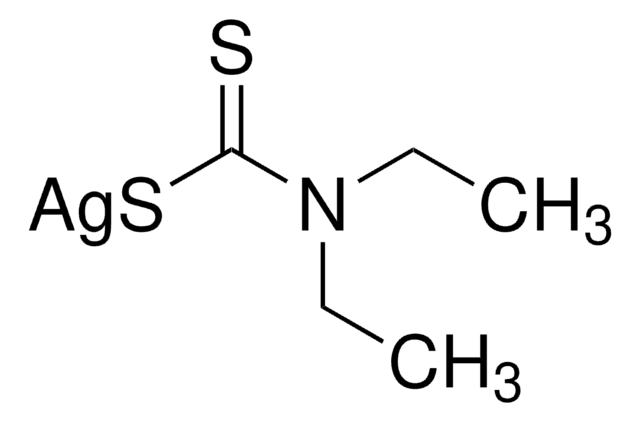1.01515
Silver diethyldithiocarbamate
for analysis EMSURE®,Reag. Ph Eur
Synonim(y):
Silver diethyldithiocarbamate, Diethyldithiocarbamic acid silver salt
About This Item
Polecane produkty
agency
reag. Ph. Eur.
Poziom jakości
linia produktu
EMSURE®
Próba
≥99 % ((DSC (differential scanning calorimetry)))
Formularz
solid
pH
5.0-6.5 ( in H2O, suspension)
mp
178-183 °C
gęstość nasypowa
340 kg/m3
temp. przechowywania
2-8°C
ciąg SMILES
CCN(CC)C(=S)[S-].[Ag+]
InChI
1S/C5H11NS2.Ag/c1-3-6(4-2)5(7)8;/h3-4H2,1-2H3,(H,7,8);/q;+1/p-1
Klucz InChI
NSVHDIYWJVLAGH-UHFFFAOYSA-M
Powiązane kategorie
Zastosowanie
- Arsenite tolerance and removal potential of the indigenous halophilic bacterium, Halomonas elongata SEK2.: This study explores the application of silver diethyldithiocarbamate in bioremediation, specifically its role in enhancing arsenite removal by Halomonas elongata SEK2. This research provides insights into the potential of using complexed silver compounds in environmental cleanup efforts, particularly in saline environments where traditional methods may fail. The findings could significantly impact wastewater treatment and environmental sustainability practices (Tavoosi et al., 2024).
- The development and use of an innovative laboratory method for measuring arsenic in drinking water from western Bangladesh.: This paper details the use of silver diethyldithiocarbamate in a novel analytical method to measure trace levels of arsenic in drinking water. This development not only enhances the accuracy and sensitivity of arsenic detection but also demonstrates the critical role of silver diethyldithiocarbamate in public health monitoring, offering a significant improvement over traditional testing methods (Frisbie et al., 2005).
- Methods of analysis for toxic elements in food products. 2. Review of USSR standards on determinations of heavy metals and arsenic.: This review discusses various methods, including the use of silver diethyldithiocarbamate, for the analysis of toxic elements in food products. The article highlights the importance of stringent quality control in food safety and the role of advanced chemical reagents in ensuring the reliability of detection methods in the food industry (Skurikhin, 1989).
Komentarz do analizy
Identity (IR-spectrum): passes test
Appearance of solution (in pyridine): passes test
pH-value (aqueous suspension): 5.0 - 6.5
Melting range (DSC (differential scanning calorimetry)): 178 - 183 °C
Spec. Absorptivity A 1%/1cm (of the As-complex; 525 nm; 0.00033 %; 1 cm; pyridine): ≥ 1500
Nitrate (NO₃): ≤ 0.01 %
Loss on Drying (105 °C): ≤ 0.5 %
Sensitivity (for determination of arsenic): passes test
Informacje prawne
Nie możesz znaleźć właściwego produktu?
Wypróbuj nasz Narzędzie selektora produktów.
Kod klasy składowania
11 - Combustible Solids
Klasa zagrożenia wodnego (WGK)
WGK 3
Temperatura zapłonu (°F)
Not applicable
Temperatura zapłonu (°C)
Not applicable
Certyfikaty analizy (CoA)
Poszukaj Certyfikaty analizy (CoA), wpisując numer partii/serii produktów. Numery serii i partii można znaleźć na etykiecie produktu po słowach „seria” lub „partia”.
Masz już ten produkt?
Dokumenty związane z niedawno zakupionymi produktami zostały zamieszczone w Bibliotece dokumentów.
Klienci oglądali również te produkty
Nasz zespół naukowców ma doświadczenie we wszystkich obszarach badań, w tym w naukach przyrodniczych, materiałoznawstwie, syntezie chemicznej, chromatografii, analityce i wielu innych dziedzinach.
Skontaktuj się z zespołem ds. pomocy technicznej






